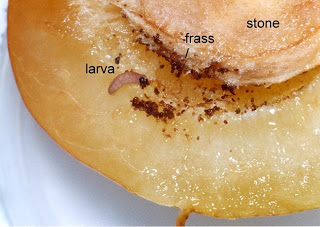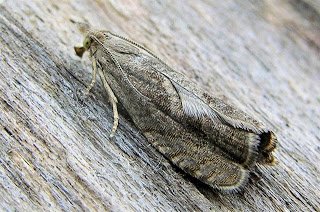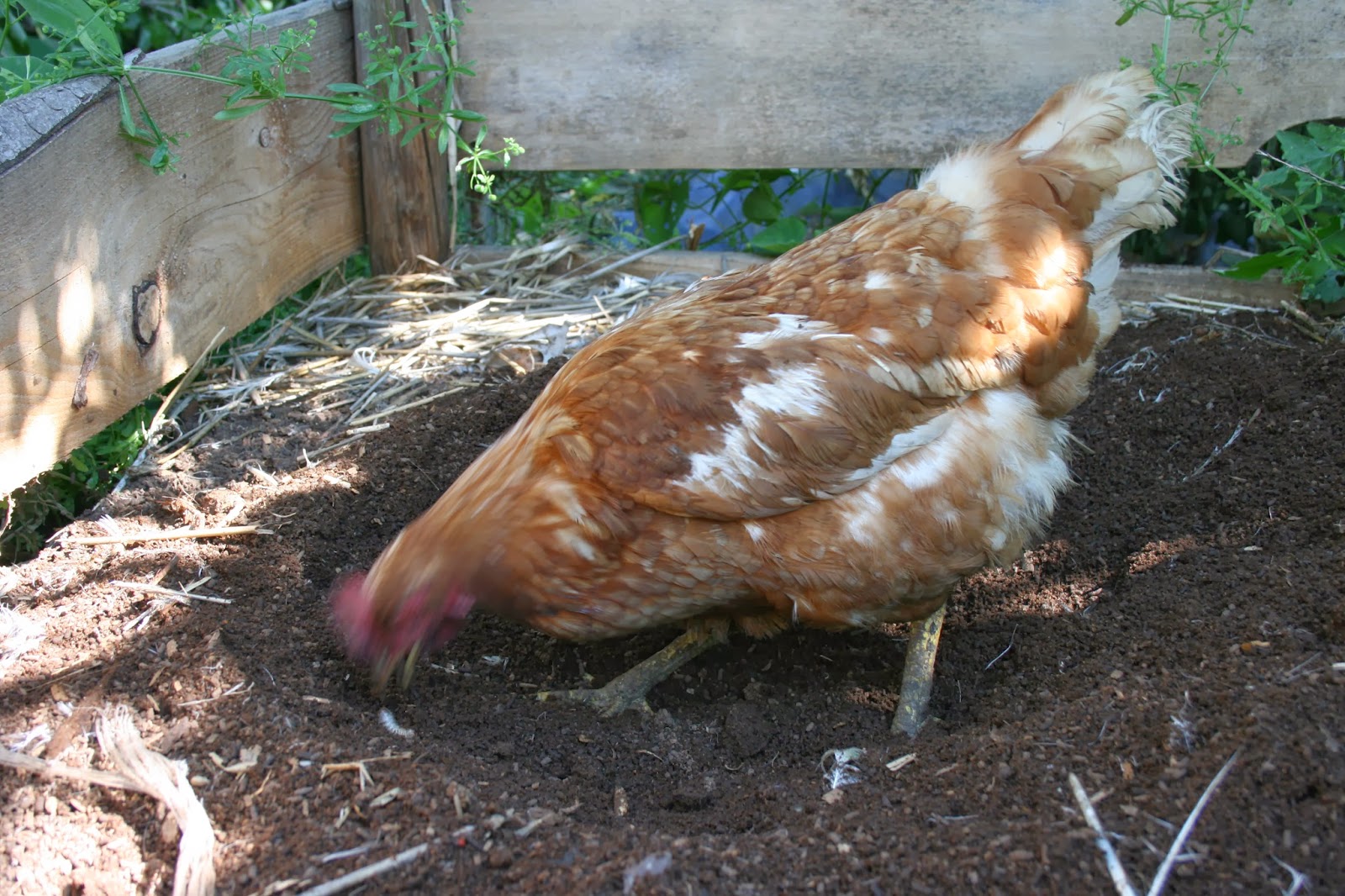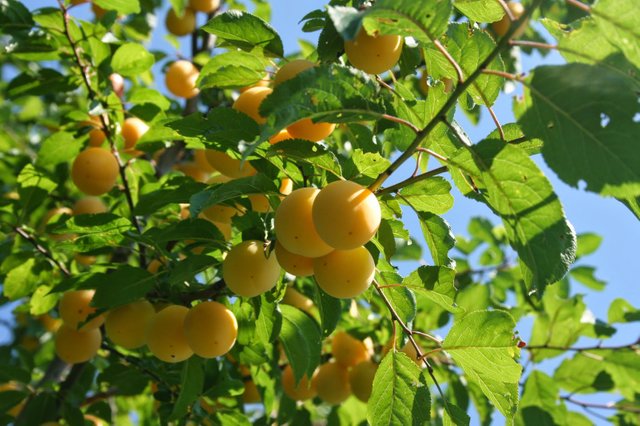Balkan Ecology Project - Sharing Plums
You may have come across small pinkish maggots in a plum before. The maggots are often found near the stone and are accompanied by tiny parcels of dark coloured material. The organism you have seen is Grapholita funebrana, the Plum Moth and more specifically, the caterpillar (larva) of the Plum Moth. The dark coloured material is their droppings (frass) and they make an otherwise perfect plum seemingly inedible.
Whilst picking plums in late August from a wonderful plum tree in our garden I noticed that the Plum Moth larvae so frequently found in the early ripening fruit from July - early August were absent from the later ripening fruits. I assumed it must have something to do with the organism's life cycle and so embarked upon a little research to find out more.

Larva of Grapholita funebrana (Plum Moth) observed in early - mid summer
G. funebrana (Plum Moth) emerges from a cocoon as an adult moth from late May - mid July. The adult moths mate with each other and the females then proceed to lay their eggs on the small ripening fruits. Caterpillars (larvae) hatch from these eggs, tunnel into the fruits and feed on the "flesh" around the stone until fully fed. At this point the caterpillar (larva) emerges from the fruit and finds a cozy concealed spot either in the tree, on surrounding fallen dead branches or in the soil. Here they spin a silk cocoon (pupa) in which they overwinter, emerging as adults in the spring. If climatic conditions are favourable, some first generation caterpillars may pupate early and emerge as adults later on in the same season, laying their eggs in the ripe fruits. Three generations during spring and summer have been reported in some places.

Adult Grapholita funebrana 4 -7.5 mm long
We always have a long warm summer here and two generations are likely. It seems the bulk of our plums ripen before the second generation can begin to do damage. The early plums that are infected make good fruit for drying. We cut the fruit in two, collect the larva for the chickens, scrap off the tiny amount of frass and leave to dry on a tray in the car with the windows slightly cracked. They are delicious :)
In our gardens the plum moth does not really bother us, however when growing fruit on a larger scale this organism can cause significant loss to a harvest. This specie and other members of the genus Grapholita are commonly associated with many plants in the Prunus Genus, and Grapholita funebrana is one of the most important lepidopteran pests of fruit in Europe. Larvae can cause significant damage to apricot, cherry, peach, plum, and other Prunus species. The following are signs of infestation:
Presence of eggs on fruit and fruit stalks.
Entry holes on fruit surface.
Dissecting a suspicious fruit may reveal larvae or frass in flesh near the seed.
An infested fruit may show symptoms such as discoloration, gummy droplets oozing out of the caterpillar’s entry hole, premature ripening and fruit drop.
Solutions
Having a good understanding of the "problem organism" is crucial to providing solutions and can help us in a number of ways
We may be able to prevent the organism becoming a problem altogether by putting in place effective control measures that break the pest's life cycle before it becomes a nuisance.
We will know at what stage an organism is going to inflict damage on a crop.
We will know when the organism is most vulnerable to means of control.
We will know what we are looking for and will be able to identify a problem early on.
To recap on the Plum Moth life cycle we have the following stages: Adult - Eggs - Larva (caterpillar)- Pupa (cocoon). At each stage it may be possible to reduce the population numbers.
The adults are most active between 18 and 22°C. The moths rest on the tree leaves during the day, becoming more active after sunset. The adult moths are generally sexually active before sunrise and lay most of their eggs in the evening. A healthy diverse garden/farm ecosystem will naturally support many bird and bat species who feed on the adults moths and larval stages. We can focus these allies by placing bird feeders in fruit trees particularly when the the temperatures rise above 18C. Commonly used commercially is the Phereomone trap. This trap gives off the pheromone (the secreted or excreted chemical factor) of the female moths, thereby attracting male moths and trapping them thus preventing mating. It's costly and time consuming and is not100% effective.
The Eggs are deposited by adults around sundown at temperatures around 25°C. The females deposit 3 to
5 eggs per fruit. Eggs hatch in about 1 to 2 weeks. It's not at all practical to intercept at this stage.
The Larva is the stage of the life cycle that one is most likely to come across and can easily be removed with the infected fruit and destroyed, thereby preventing future generations. The fact we feed the larvaa to the chickens when preparing the early fruit for drying prevents further propagation and is why it's important not to let fallen fruit accumulate under a tree.
Pupa:The larvae pupate in bark crevices or protected areas in the soil. Poultry are expert foragers for small parcels of nutrients such as a pupa. By arranging a coop around the base of your fruit trees during late May to mid July the poultry will scratch relentlessly for foods such as the Pupae and deliver some welcome nutritional excrement whilst at it. Blue and Great Tits feed on the pupa and can be attracted to the trees with balls of fat and seeds. French research has found that an adult tit can consume 12000-18000 of hibernating moth caterpillars per year. Hanging feeders in trees during the winter is also of benefit.

Relentlessly at work in the compost pile.
We can also mitigate the damage done by these organisms by considering the host plant. We may be able to establish good control of the specie on our site, but if there are plums trees in neighbouring gardens or wild plums in the windbreaks or hedgerows and the fruit is unpicked, local populations may grow rapidly and soon be looking for new breeding/feeding grounds.
When considering growing plums, it's well worth observing local plum trees and other host species for signs of the Plum Moth. By studying the fruit of local wild plums or organically grown plums along with average temperatures records, you may be able to work out at what point the fruit ceases to be infected and choose a variety that ripens during the time period between generations. You may also observe that the wild fruits are not that troubled by these pests at all . It appears to me that many of the local wild plums Prunus cerasifera and Prunus insititia in the relatively undisturbed (wild) areas around us are largely unaffected by the Plum Moth but that the isolated trees in fields, garden trees and trees in poor locations (i.e compacted soils) tend to be targets. Perhaps trees in healthy communities can repel the moths in some way?

Prunus cerasifera - Myrobalan Plum / Cherry Plum
Susceptible Cultivars
Some Plum cultivars are noted for being more susceptible to damage from the Plum Moth such as Czar and Victoria as well as Amers, Anna Spath, Buhlertal Prune, Emma Leppermann, Italian Prune, Lowan, Stanley, Valjevka, Valor and Wangenheim Prune. (Agroforestry Research Trust Volume 9 No.1 pg3).
If you would like to learn more about Grapholita funebrana - Plum Moth , it is worth noting that it is often referred to as Cydia funebrana in older literature.